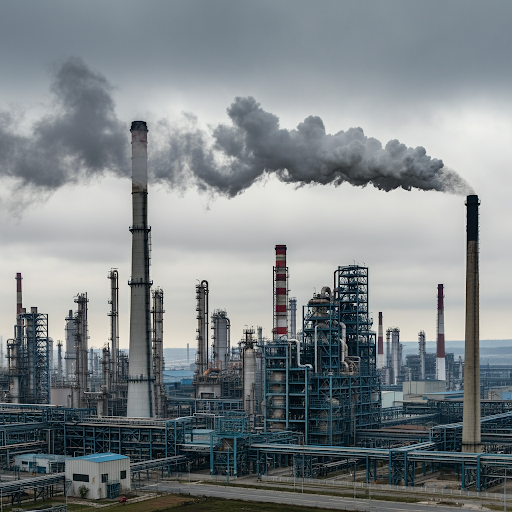-
Call us
-
Send email
Blog Details
27Nov
Reducing Carbon Footprints in Chemical Manufacturing with Green Chemistry
by ticzenfold, 0 Comments
The chemical industry is essential to modern life, providing us with everything from medicines and fertilizers to plastics and fuels. However, traditional chemical manufacturing processes often involve the use of hazardous substances and generate significant amounts of waste and pollution and is a major contributor to global greenhouse gas emissions.This has a major impact on the environment and human health, contributing to climate change, air and water pollution, and resource depletion.In the face of climate change, industries worldwide are seeking ways to minimize their environmental impact.
The chemical manufacturing companies in India, are a significant contributor to global carbon emissions, are adopting green chemistry as a transformative approach. This innovative field prioritizes sustainability by rethinking chemical processes, reducing waste, and substituting hazardous substances with environmentally friendly alternatives. Zenfold Sustainable Technologies is at the forefront of this revolution, driving change through sustainable practices and cutting-edge innovations in green chemistry. Green chemistry offers a solution to these challenges. By applying green chemistry principles, we can design chemical products and processes that minimize or eliminate the use and generation of hazardous substances. This reduces the environmental impact of chemical manufacturing and helps to create a more sustainable industry.
The Hidden Carbon Toll of Chemical Manufacturing
Chemical manufacturing is not just about creating products; it’s about energy, resources, and emissions. Here’s a closer look:
Energy Guzzlers: Chemical processes often require extreme heat and pressure, consuming vast amounts of fossil fuel-derived energy.
Feedstock Dependence: Most chemicals rely on petroleum-based raw materials, contributing to greenhouse gas (GHG) emissions.
Toxic Waste: By Products of chemical processes frequently pose disposal challenges, amplifying the environmental burden.
Transport Emissions: Moving raw materials and finished products adds another layer of carbon intensity.
- The combined effect is staggering: the sector emits over 2.5 billion metric tons of CO₂ annually, accounting for nearly 8% of global emissions.
- The solution lies in reimagining these processes through the lens of green chemistry, turning challenges into opportunities.

What Makes Green Chemistry the Future?
Green chemistry isn’t just an alternative—it’s the next evolution of chemical manufacturing. Its foundation lies in 12 guiding principles, each designed to minimize harm while maximizing efficiency. These include:
Preventing Waste: Stop pollution at its source rather than managing it later.
Safer Alternatives: Use less toxic and more biodegradable substances in processes.
Energy Efficiency: Design reactions to occur at room temperature or pressure, minimizing energy use.
Renewable Resources: Shift away from finite petrochemical feedstocks to bio-based or recycled alternatives.
Circular Design: Create products that can degrade harmlessly or be recycled seamlessly.
This forward-thinking framework empowers manufacturers to innovate sustainably while achieving tangible results in reducing carbon footprints.
How Green Chemistry Can Reduce Carbon Footprints
Green chemistry principles can be applied to all aspects of chemical manufacturing, from the initial design of a chemical product to the end of its life cycle. Here are some examples of how green chemistry can be used to reduce carbon footprints:
Using renewable feedstocks: Traditional chemical manufacturing relies heavily on fossil fuels as feedstocks. Green chemistry promotes the use of renewable feedstocks, such as biomass, which can significantly reduce greenhouse gas emissions.
Designing safer chemicals: Green chemistry encourages the design of chemicals that are less toxic and persistent in the environment. This reduces the risks associated with chemical manufacturing and helps to protect human health and the environment.
Using less energy: Many chemical processes require high temperatures and pressures, which consume large amounts of energy. Green chemistry aims to develop processes that are more energy-efficient, reducing greenhouse gas emissions and operating costs.
Reducing waste: Traditional chemical manufacturing often generates large amounts of waste. Green chemistry aims to minimize waste by designing processes that are more efficient and by developing methods to recycle or reuse waste products.
Using catalysts: Catalysts can increase the efficiency of chemical reactions, reducing the amount of energy required and the amount of waste generated. Green chemistry encourages the use of catalysts that are environmentally friendly and can be easily recovered and reused.

Green Chemistry Benefits Beyond Carbon
Green chemistry isn’t just about cutting emissions—it delivers a cascade of benefits that extend to businesses, communities, and the planet.
Environmental Benefits
- Lower GHG emissions and air pollution.
- Safer waste streams, reducing contamination risks.
- Conservation of finite resources like petroleum and minerals.
Economic Advantages
- Cost Savings: Energy-efficient processes reduce operational costs.
- Market Growth: Eco-conscious consumers prefer sustainable products.
- Regulatory Compliance: Staying ahead of stricter environmental laws avoids penalties and secures competitive advantages.
Social Responsibility
- Enhanced public trust in companies adopting green practices.
- Healthier workplaces and communities through reduced exposure to toxins.
Advancing Sustainability: Green Chemistry at Zenfold Sustainable Technologies
-
At Zenfold Sustainable Technologies, our commitment to environmental stewardship is at the core of everything we do. Our state-of-the-art R&D facility in Bangalore is powered by a team of highly qualified experts, dedicated to designing and implementing sustainable chemical processes. Guided by the principles of green chemistry, we innovate to minimize environmental impact while maintaining excellence in product quality.
-
Here’s a closer look at the sustainable methodologies we employ:
1. Shortcut Chemistry Methods and Novel Transformations
Efficiency and precision are fundamental to our approach. By employing shortcut chemistry methods and novel transformations, we ensure:
High Atom Economy: Every atom in the starting materials is utilized to the fullest, reducing waste.
- Resource Optimization: We minimize raw material usage and energy consumption, ensuring cost-effectiveness and eco-friendliness.
2. Novel Catalysis for Improved Reactions
Catalysis is the heart of many chemical processes. At Zenfold, we:
- Develop highly selective and specific catalysts to reduce undesired by-products.
- Enhance reaction speeds, minimizing time and energy requirements.
This results in processes that are not only faster but also environmentally sustainable.
3. High-Throughput Screening for Optimization
Innovation thrives on precision. Using parallel high-throughput screening, we can:
- Experiment with multiple reaction parameters simultaneously.
- Rapidly identify the most efficient and sustainable process conditions.
This accelerates the transition from R&D to industrial-scale production.
4. Reducing Organic Solvent Usage
Solvents are a significant contributor to chemical waste. At Zenfold, we focus on:
- Replacing organic solvents with water, whenever feasible, as a greener alternative.
- Reducing solvent volumes to minimize hazardous waste generation.
5. Effluent Reduction Strategies
Effluent management is vital for environmental sustainability. Our processes are designed to:
- Generate minimal effluents, reducing the burden on waste treatment systems.
- Comply with strict environmental regulations, ensuring responsible chemical manufacturing.
6. Green Extraction Techniques
Extraction is a critical step in chemical production, and we prioritize environmentally safe methods, such as:
- Supercritical Fluid Extraction: Utilizing CO₂ under specific conditions to replace harmful solvents.
- Subcritical Water Extraction: Using water at elevated temperatures and pressures to extract compounds efficiently.
Biotransformation: Merging Chemistry with Biology
Biotransformation at Zenfold blends traditional chemistry with biocatalysis and fermentation, creating synthesis routes that are both cost-effective and environmentally friendly.
Key Areas of Focus:
- Chiral Molecules
- Chiral molecules are essential in pharmaceutical and chemical applications. We leverage advanced biotransformation methods to produce high-purity chiral compounds.
- Enzyme and Microbial Screening
- Our R&D teams identify and develop desirable catalysts through meticulous screening processes.
- Lab-to-Scale Optimization
We refine fermentation and biocatalysis processes from laboratory research to pilot and industrial scales. - Cost Optimization
- By optimizing enzyme dosage and implementing enzyme recycling strategies, we ensure economic viability without compromising sustainability.
- Immobilized Enzymes in Continuous Processes
- Immobilized enzymes offer superior efficiency in continuous production systems, enhancing both output quality and environmental performance.
Regulatory Compliance and Biosafety
Our operations are aligned with regulatory frameworks to uphold biodiversity and biosafety. We take meticulous care to manage recombinant strains responsibly, ensuring safety and environmental protection at every stage.
Products Crafted with Sustainability
The application of green chemistry extends across our product range, which includes:
- Pharma Intermediates
- Veterinary APIs
- Electronic Chemicals
- Nutraceuticals
Each product is a testament to our dedication to innovation, quality, and sustainability.
Partner with Zenfold for a Greener Future
-
Let’s Build a Greener Tomorrow
Every action counts in the fight against climate change. Whether you’re a manufacturer, policymaker, or consumer, embracing green chemistry is a step toward a sustainable future.
At Zenfold Sustainable Technologies, we’re more than just a chemical company in India; We promote sustainable chemical manufacturing processes that help in reducing carbon footprints and fostering innovation.
Join us in making an impact:
Transition to eco-friendly manufacturing processes.
Develop products with a focus on life cycle sustainability.
Contribute to a carbon-neutral future with our advanced solutions.
Let’s together rewrite the story of chemical manufacturing—one green innovation at a time. Together, we can reduce emissions, preserve resources, and create a legacy of sustainability.
Green chemistry is a powerful tool to revolutionize the chemical manufacturing industry. By adopting sustainable practices and reducing carbon footprints, we can mitigate climate change’s impact while ensuring economic growth.
Partner with Zenfold Sustainable Technologies to lead this transformation. Let’s innovate responsibly and build a brighter, greener future for generations to come.
To learn more about our products, services, and technologies, contact us at:
📞 Call Us: 080-22117089
📧 Email: info@zenfoldst.com
Let’s join hands to pave the way for a cleaner, greener world—one molecule at a time.
Recent Posts
- India’s Semiconductor Industry: A Key Player in Global Supply Chains
- How India is Transforming into a Global Semiconductor Hub
- Why India is the Future of Semiconductor Sourcing
- Exploring Zenfold Sustainable Technologies’ Innovative Approaches in Chemical Manufacturing Supply Chain Management
- Reducing Carbon Footprints in Chemical Manufacturing with Green Chemistry
